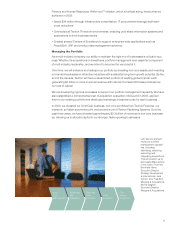E-Z-GO 2003 Annual Report Download - page 21
Download and view the complete annual report
Please find page 21 of the 2003 E-Z-GO annual report below. You can navigate through the pages in the report by either clicking on the pages listed below, or by using the keyword search tool below to find specific information within the annual report.
In 2004, total revenues are expected to decrease slightly as lower aircraft revenue at both Bell and
Cessna are expected to be partially offset by higher sales volume at Kautex. At Bell, delivery volumes
should be stable, but revenues are expected to be lower on the V-22 program, as development efforts
wind down and revenues related to new production releases are recorded on an as-delivered basis. At
Cessna, the decrease in revenues is the result of expected sales of between 165 and 170 jets in 2004,
compared with 197 jets in 2003.
Overall segment profit and margins are expected to increase as Textron continues to realize the benefits
of its strong cost reduction and restructuring initiatives as a means to mitigate the impact of the lower
revenue.
Textron’s commercial backlog was $5.5 billion and $6.1 billion at the end of 2003 and 2002, respectively,
and is primarily related to Cessna. U.S. Government backlog was $1.9 billion and $1.5 billion at the end
of 2003 and 2002, respectively, which was substantially all in the Bell segment.
In June 2003, Textron reorganized its segments in order to streamline its management reporting struc-
ture. Under the new structure, Textron Systems and Lycoming have been combined with Bell Helicopter
to form the new Bell segment, and Cessna Aircraft is being reported separately as a new segment. The
remaining Industrial Products and Industrial Components businesses have been combined to form the
new Industrial segment. Textron now reports under the following segments: Bell, Cessna, Fastening Sys-
tems, Industrial and Finance.
Bell is a leading manufacturer of advanced military helicopters and tiltrotor aircraft for the U.S. Govern-
ment and commercial helicopters for corporate, offshore, utility, charter, police, fire, rescue and emer-
gency medical customers. Additionally, Bell is a primary supplier of advanced weapon systems to meet
the demanding needs of the aerospace and defense markets and the leading manufacturer of piston
aircraft engines.
Bell has two major programs with the U.S. Government – the V-22 and the H-1 Upgrade Program. The V-
22 is the pioneer program for tiltrotor technology with a current requirement of 458 aircraft. Bell expects
to receive authorization to proceed to full-rate production of the V-22 in 2005. The H-1 Upgrade Program
is a major upgrade to remanufacture the U.S. Marine Corps’ fleet of AH-1W SuperCobra and UH-1N utili-
ty helicopters to an advanced configuration featuring common avionics and flight dynamics. The current
program anticipates the remanufacture of 100 UH-1N and 180 AH-1W helicopters, and in 2003, Bell
received a contract award for six UH-1Y aircraft and three AH-1Z aircraft that will begin deliveries in
2006. Bell expects to receive authorization to proceed to full-rate production of the H-1 in 2005 with air-
craft deliveries to continue through 2013.
Textron continues to manufacture aircraft under the V-22 low-rate initial production releases that began
prior to 2003. Revenues under those releases are recorded on a cost incurred basis primarily as a result
of the significant engineering effort required over a lengthy period of time during the initial development
phase in relation to total contract volume. Revenues for those releases are expected to decline through
2007 as the remaining effort is completed. The development effort is substantially complete for new pro-
duction releases in 2003, and revenue on those releases will be recognized as units are delivered,
which is expected to begin in late 2004. Accordingly, during 2004, revenues on the V-22 program are
expected to decrease as development efforts wind down and revenues related to new production
releases are recorded on an as-delivered basis.
The Bell segment’s revenues increased $113 million in 2003, due to higher U.S. Government revenue of
$62 million primarily due to the ongoing development efforts on the V-22 program and higher foreign mil-
itary sales volume of $35 million related to a contract that began shipments during the third quarter of
2002.
Revenue decreased $8 million in 2002 primarily due to lower commercial sales volume of $101 million
largely due to lower demand for commercial helicopters in the corporate market, partially offset by high-
er revenue from the U.S. Government of $94 million primarily related to the ongoing development efforts
on the V-22 program.
19
























